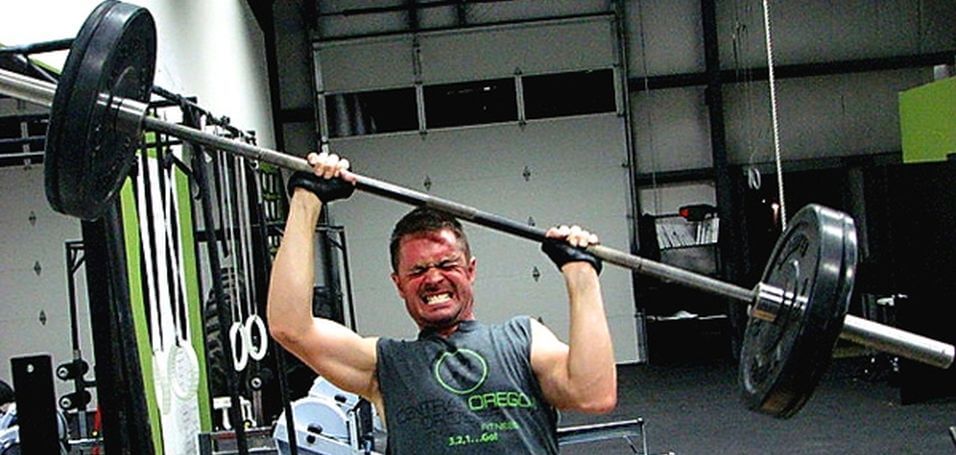Blood flow restriction training is making waves of late.
It sounds new. It sounds scientific. And some are saying it’s revolutionary.
Well, it also smacks of artifice. Like it was contrived by marketers to sell the latest round of magazines, pills, and powders.
And so if you’ve been skeptical, good. You should be.
You see, the more time you spend educating yourself in the ways of muscle building, the more you become certain of one thing:
If something sounds too good to be true — too easy, too effective, too innovative — it almost always is.
Eventually, you learn that there really is no shortcut to building a strong, muscular, lean body.
There are right and wrong ways of going about it, of course, but at least 80% of your long-term results will come from diligent application of the fundamentals:
- An emphasis on heavy compound lifting.
- Sensible workout programming.
- Ensuring you recover adequately.
- Proper diet and nutrition.
Everything that falls outside of those boundaries should be viewed with a gimlet eye. As, at best, marginally important.
Which brings us to the subject at hand: blood flow restriction training (also known as occlusion training).
What is it? How is it supposed to work? How effective is it? Is it dangerous? How do you do it correctly?
Well, this article is going to give you answers to all those questions and more. By the end, you’re going to have everything you need to determine whether BFR is right for you and how to do it safely and effectively.
- What is Blood Flow Restriction Training?
- How Does Blood Flow Restriction Training Work?
- Can Blood Flow Restriction Training Increase Muscle Growth?
- Is Blood Flow Restriction Training Dangerous?
- How to Do Blood Flow Restriction Training Correctly
- Don't Make These 4 BFR Mistakes
- The Bottom Line on Blood Flow Restriction Training
Table of Contents
+Want to listen to more stuff like this? Check out my podcast!
What is Blood Flow Restriction Training?

Blood flow restriction training involves, well, restricting blood flow to a muscle group while training.
It’s also called “occlusion training” and “KAATSU training.”
The first thing you need to know about BFR is the goal isn’t to completely cut off blood supply to a muscle.
It’s simply to slow down the rate at which blood returns from the muscles to the heart.
This causes blood to remain inside your muscles for longer than normal, which, as you’ll soon see, influences muscle physiology in several ways.
How Does Blood Flow Restriction Training Work?
Blood is the body’s delivery system for oxygen, nutrients, glucose, hormones, and other compounds needed to simply stay alive, let alone lift weights, jump, run, and the like.
That’s why muscles require a steady supply of blood to work.
Your heart pumps blood to your muscles via arteries, which are large, muscular-walled tubes running throughout the body. That blood makes it way back to the heart through veins, which are a different set of tubes crisscrossing your body.
When you engage in resistance training, and especially in higher rep ranges, the amount of blood going from your heart to your muscles outpaces the amount returning from your muscles to your heart.
That’s part of why you get a pump when you lift weights.
That pump diminishes when you rest in between sets because arterial blood flow drops and blood is slowly evacuated from the engorged muscles back to the heart.
Well, the point of blood flow restriction training is to prolong the pump.
This is accomplished by tying a band around the limb(s) you’re training, which allows blood to pump in but restricts the flow out.
Now, pumps are cool and all, but how could that possibly affect muscle growth, you’re wondering?
Keep reading to find out.
Can Blood Flow Restriction Training Increase Muscle Growth?

The short answer is yes, it can, and there are several ways it does this.
Let’s look at each.
When you’re working out, your muscle cells burn through energy at a much faster rate than normal.
As they churn through fuel stores, metabolic byproducts build up faster than your body can clear them out, and some of these molecules act as anabolic signals, telling your body to increase muscle size and strength.
In technical jargon, this process is known as “metabolic stress,” and it’s one of the three primary mechanical ways you can trigger muscle growth (with progressive overload and muscle damage being the other two).
Because blood flow restriction training slows the rate at which these byproducts are flushed from your muscles, it allows them to hang around longer and have a greater anabolic effect on muscle cells.
In other words, it amplifies the muscle-building power of metabolic stress.
Resistance training also causes cells to expand and fill with fluid and nutrients. This is known as “cellular swelling,” and it too acts as a signal for muscle growth.
Occlusion training magnifies the muscle-building power of this, too, by increasing the amount of time that your muscle cells stay swollen.
Research also shows that blood flow restriction can enhance certain genetic signalling pathways involved in muscle growth.
You see, your body uses a complex network of chemical messengers to tell cells to grow or shrink.
One of them that says “grow” is the protein called the mammalian target of rapamycin (mTOR), and one that says “shrink” is the protein myostatin.
Studies show that blood flow restriction training increases levels of mTOR and lowers myostatin levels, which creates an environment in your body more conducive to muscle growth.
Blood flow restriction can also cause muscle cells to release their own anabolic hormones through a process known as autocrine signalling, and by keeping blood pooled in the muscles for longer periods, these hormones have more time to interact with muscle cells.
Yet another way BFR can help you gain muscle faster has to do with what happens when you push your muscles to the point of failure, where you simply can’t get another rep.
You’ve probably heard that muscles only grow in response to the last few reps of your sets–the grinders that light your muscle bellies on fire.
That’s not exactly true, but it’s not wholly off-base, either.
You see, one of the easiest ways to ensure you continue to overload, damage, and fatigue your muscles is to frequently push them to failure, or close to it (one or two reps shy).
When you do this, you activate much higher amounts of muscle tissue than with easier sets, and this positively influences muscle building.
That’s why regularly pushing your muscles to the point of failure, or just shy of it, is a very important aspect of gaining muscle and strength.
Now, with a normal weightlifting set, you only reach this point at the very end, after you’ve already done several reps.
Thus, if you wanted to increase the number of times your muscles taste failure in a workout, you’d need to do more sets and a lot more reps.
This is well and fine, but you can only do so much work per major muscle group per week before your body falls behind in recovery and overtraining symptoms set in.
(And this is especially true if you’re emphasizing heavy, compound weightlifting in your workouts, like you should be.)
Blood flow restriction training is helpful in this regard because while it doesn’t inherently boost muscle activation levels more than normal training, it does allow you to achieve higher total levels of muscle activation in a workout with less muscle damage than would otherwise occur.
It’s similar to rest-pause training and, in a sense, “tricks” your muscles into thinking you’re using much heavier weights than you really are.
So, to summarize, here are the benefits of BFR:
- By using lighter weights, your tendons, ligaments and joints aren’t placed under as much strain, which allows you to do more volume with less risk of injury or overtraining.
This can also be helpful if you’re already injured or dealing with some nagging aches and pains. BFR allows you to train more effectively with lighter weights that (hopefully) don’t aggravate the problems.
Being able to produce a decent muscle-building stimulus with lighter weights is also useful if you have to train in a poorly equipped gym.
- Assuming you’re not a new weightlifter, research shows adding BFR sets to heavy traditional sets can increase strength more than heavy training alone.
- If you’re deloading or taking a longer break from training, you can use blood flow restriction training to better maintain your conditioning with much less muscle damage and fatigue.
- If you’re not feeling up to a heavy workout for whatever reason, you can use BFR to have an effective but less stressful training session.
So, as you can see, there are plenty of reasons to dabble with this rather unusual training method.
The big question at this point, though, is safety.
Is it dangerous?
Is Blood Flow Restriction Training Dangerous?

Stinting blood supply to muscles while working out sounds like a bad idea. Like something with a long list of nasty side effects.
Well, surprisingly, research shows there’s no evidence that blood flow restriction training is dangerous.
This makes sense when get past the first impression because it only involves reducing blood flow out of muscles, not stopping it from entering muscles, which would be dangerous.
This means that you have to make sure the cuffs/bands aren’t too tight, but, as you’ll see, this is pretty easy to do. If they’re tight enough to cause problems, they’re going to be very uncomfortable and you’re going to start losing feeling in your limb(s), which is impossible to miss.
And even if you’re a real gung-ho, “no pain no gain” type, studies on medical tourniquets have shown that you would have to completely cut off blood flow to a limb for about two hours to cause nerve and muscle damage.
So you basically have to deliberately try to get hurt with BFR to actually mess it up.
One other common concern with occlusion training is that artificially increasing muscle pump and swelling is going to damage the muscles in some way.
It won’t.
Remember the same effects happen when you do a lot of reps to failure. BFR just makes them last longer.
How to Do Blood Flow Restriction Training Correctly
The first thing you need to know about BFR is it’s just for arm and leg training. There’s no practical way to restrict blood flow in any other major muscle groups.
And the first thing you’re going to need to actually do it is a way to reduce blood flow.
Quick-release medical tourniquets tend to be best for the arms, and elastic knee wraps or exercise bands are usually easiest for the legs.
Next is learning how to wrap your arms and legs properly.
- If you’re wrapping your arms, the band should be tucked into your armpit.
- If you’re wrapping your legs, the bands should be nudged up against your crotch.
- In terms of tightness, you should be going for a 9 out of 10 for the arms, and a 7 out of 10 for the legs.
Once you have the right tools and know how to use them, you’re ready to go. From here, all you need to know is…
Continue with your current strength training plan.
Remember that BFR is something to be worked into a well-designed workout program. It shouldn’t be all that you do.
Save blood flow restriction for your accessory exercises.
You should still begin your workouts with your heavy compound sets.
These are core muscle and strength builders that can never be replicated or replaced, really, so save the BFR for later in your workouts.
Specifically, use it on your “accessory exercises,” which are usually isolation exercises that can be safely taken to muscle failure.
For example, dumbbell curls, leg extensions, triceps pushdowns, and leg curls.
Start with doing 3 to 5 BFR sets per workout with a weight that allows for 20 to 30 reps (about 50% of 1RM if you’re an experienced weightlifter).
I also recommend a 2-0-2 rep cadence, which means 2 seconds down, no pause, and 2 seconds up.
That’s all there is to it.
Don’t Make These 4 BFR Mistakes

As simple as occlusion training is, there are plenty of ways to mess it up.
Here are the four most common mistakes that I see people making with it. Don’t be one of them!
Mistake #1
Using blood flow restriction before it can really benefit you.
Studies show that beginners don’t benefit as much from BFR as more advanced lifters.
The reason for this is simple:
When you’re new to weightlifting, your body is hyper-responsive to it. It reaches its “anabolic ceiling” fairly easily with just proper diet and progressive overload, making BFR redundant.
So, if you have less than a year of proper weightlifting under your belt, shelve BFR for now. Stick with traditional lifting.
The exception here is injury. If you’re a newbie but injured, you can use BFR to get in volume while you recover.
Mistake #2
Tightening the tourniquets until they hurt.
Remember: you’re not looking to cut off blood flow completely.
You want enough pressure to restrict the flow of blood back to the heart but not so much that blood can’t make its way into your muscles.
As I mentioned earlier, the sweet spot is at a tightness of about 7 to 9 on a scale of 1 to 10.
Mistake #3
Going too heavy with the weights.
You might be surprised how quickly you run out of steam when you first try blood flow restriction.
That’s why you want to err on the side of using less weight, not more. Start light and increase incrementally until you’ve got it dialed in.
Mistake #4
Exclusively using blood flow restriction instead of heavy weight training.
I have to say it again:
Blood flow restriction training isn’t a replacement for traditional weightlifting.
While it does produce more metabolic stress, it doesn’t produce much muscle damage or overload, which are more powerful muscle-building stimuli.
There’s also the issue of exercise limitations.
If you want to build a strong, muscular physique as quickly as possible, you’re going to need to focus on several key lifts:
And BFR only lends itself to the squat.
The Bottom Line on Blood Flow Restriction Training
Workout magazines love to recycle old training methods as “breakthroughs” that will help you build muscle faster than ever before.
Most are overblown or unproven.
Blood flow restriction training, however, is a legitimate, science-based way to squeeze more muscle growth out of your training.
By itself, it can produce similar results to traditional strength training, and when combined with it, the overall results are magnified.
That said, occlusion training isn’t worth the hassle if you’re new to weightlifting because it’s not going to have any noticeable effects.
If you’re an experienced weightlifter, though, or if you’re injured or limited in equipment, then you may be able to benefit from it.
What’s your take on blood flow restriction training? Have anything else to add? Let me know in the comments below!
Scientific References +
- Lixandrão, M. E., Ugrinowitsch, C., Laurentino, G., Libardi, C. A., Aihara, A. Y., Cardoso, F. N., Tricoli, V., & Roschel, H. (2015). Effects of exercise intensity and occlusion pressure after 12 weeks of resistance training with blood-flow restriction. European Journal of Applied Physiology, 115(12), 2471–2480. https://doi.org/10.1007/s00421-015-3253-2
- Yasuda, T., Ogasawara, R., Sakamaki, M., Ozaki, H., Sato, Y., & Abe, T. (2011). Combined effects of low-intensity blood flow restriction training and high-intensity resistance training on muscle strength and size. European Journal of Applied Physiology, 111(10), 2525–2533. https://doi.org/10.1007/s00421-011-1873-8
- Lee, C., Porter, K. M., & Hodgetts, T. J. (2007). Tourniquet use in the civilian prehospital setting. In Emergency Medicine Journal (Vol. 24, Issue 8, pp. 584–587). BMJ Publishing Group. https://doi.org/10.1136/emj.2007.046359
- Loenneke, J. P., Wilson, J. M., Wilson, G. J., Pujol, T. J., & Bemben, M. G. (2011). Potential safety issues with blood flow restriction training. In Scandinavian Journal of Medicine and Science in Sports (Vol. 21, Issue 4, pp. 510–518). Scand J Med Sci Sports. https://doi.org/10.1111/j.1600-0838.2010.01290.x
- Luebbers, P. E., Fry, A. C., Kriley, L. M., & Butler, M. S. (2014). The effects of a 7-week practical blood flow restriction program on well-trained collegiate athletes. Journal of Strength and Conditioning Research, 28(8), 2270–2280. https://doi.org/10.1519/JSC.0000000000000385
- Kubo, K., Komuro, T., Ishiguro, N., Tsunoda, N., Sato, Y., Ishii, N., Kanehisa, H., & Fukunaga, T. (2006). Effects of low-load resistance training with vascular occlusion on the mechanical properties of muscle and tendon. Journal of Applied Biomechanics, 22(2), 112–119. https://doi.org/10.1123/jab.22.2.112
- Lowery, R. P., Joy, J. M., Loenneke, J. P., de Souza, E. O., Machado, M., Dudeck, J. E., & Wilson, J. M. (2014). Practical blood flow restriction training increases muscle hypertrophy during a periodized resistance training programme. Clinical Physiology and Functional Imaging, 34(4), 317–321. https://doi.org/10.1111/cpf.12099
- Takarada, Y., Nakamura, Y., Aruga, S., Onda, T., Miyazaki, S., & Ishii, N. (2000). Rapid increase in plasma growth hormone after low-intensity resistance exercise with vascular occlusion. Journal of Applied Physiology, 88(1), 61–65. https://doi.org/10.1152/jappl.2000.88.1.61
- Pearson, S. J., & Hussain, S. R. (2015). A Review on the Mechanisms of Blood-Flow Restriction Resistance Training-Induced Muscle Hypertrophy. In Sports Medicine (Vol. 45, Issue 2, pp. 187–200). Springer International Publishing. https://doi.org/10.1007/s40279-014-0264-9
- Laurentino, G. C., Ugrinowitsch, C., Roschel, H., Aoki, M. S., Soares, A. G., Neves, M., Aihara, A., Da Rocha Correa Fernandes, A., & Tricoli, V. (2012). Strength training with blood flow restriction diminishes myostatin gene expression. Medicine and Science in Sports and Exercise, 44(3), 406–412. https://doi.org/10.1249/MSS.0b013e318233b4bc
- Fry, C. S., Glynn, E. L., Drummond, M. J., Timmerman, K. L., Fujita, S., Abe, T., Dhanani, S., Volpi, E., & Rasmussen, B. B. (2010). Blood flow restriction exercise stimulates mTORC1 signaling and muscle protein synthesis in older men. Journal of Applied Physiology, 108(5), 1199–1209. https://doi.org/10.1152/japplphysiol.01266.2009
- Yasuda, T., Loenneke, J. P., Thiebaud, R. S., & Abe, T. (2012). Effects of Blood Flow Restricted Low-Intensity Concentric or Eccentric Training on Muscle Size and Strength. PLoS ONE, 7(12), e52843. https://doi.org/10.1371/journal.pone.0052843
- Gentil, P., Oliveira, E., & Bottaro, M. (2006). Time under tension and blood lactate response during four different resistance training methods. Journal of Physiological Anthropology, 25(5), 339–344. https://doi.org/10.2114/jpa2.25.339










